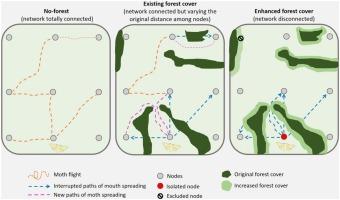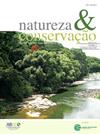空间网络揭示了森林覆盖如何减少农业害虫的传播
IF 3.5
2区 环境科学与生态学
Q1 BIODIVERSITY CONSERVATION
引用次数: 0
摘要
单一栽培造成的景观同质化为作物害虫的传播提供了最优条件。增加生境的异质性和景观的复杂性可以减缓害虫的传播。了解生境异质性在影响害虫传播中的作用的下一步是了解景观特征如何直接和间接影响空间侵染模式。我们开发了一个空间网络方法来探索由森林斑块覆盖产生的景观复杂性如何影响害虫在农业景观中的传播。以巴西甘蔗农业生态系统为研究对象,利用甘蔗螟虫(鳞翅目:革蛾科)诱捕器的空间分布和传播距离信息。网络分析表明,模拟害虫传播是甘蔗田直接和间接途径连接的结果。因此,仅使用空间网络的直接和间接路径以及侵染的初始焦点信息,我们就能够以接近80%的准确率预测模拟景观中最容易发生害虫传播的地点。通过调整病虫害迁移和与景观特征的相互作用等参数,该模型可以模拟不同的农业系统和病虫害行为,表明森林覆盖可以控制病虫害的发生,空间网络中的直接和间接路径可以作为预测工具来管理病虫害在农业景观中的传播。本文章由计算机程序翻译,如有差异,请以英文原文为准。

Spatial networks reveal how forest cover decreases the spread of agricultural pests
Landscape homogenization, caused by monocultures, can provide optimal conditions for the spread of crop pests. Increasing habitat heterogeneity and complexity within landscapes could slow pest spread. A next step in understanding the role of habitat heterogeneity in affecting pest spread is to understand how landscape features directly and indirectly affect spatial infestation patterns. We developed a spatial network approach to explore how landscape complexity, generated by forest patch cover, affects the pest spread in agricultural landscapes. As a studied system, we used information on the spatial distribution of traps and dispersal distance of the sugarcane borer Diatraea saccharalis (Lepidoptera: Crambidae) from a sugarcane agro-ecosystem in Brazil. Network analysis reveals that modeling pest spread was an outcome of both direct and indirect pathways connecting sugarcane fields. Therefore, using only information about the direct and indirect pathways of the spatial network and the initial focus of infestation, we were able to predict with nearly 80% accuracy the most susceptible sites to pest spread in the simulated landscape. By adjusting parameters such as pest mobility, and interaction with landscape features, our model can simulate different agricultural systems and pest behaviors, showing that forest cover can be used to control pest occurrence and that direct and indirect pathways in spatial networks can be used as a predictive tool to manage the pest spread in agricultural landscapes.
求助全文
通过发布文献求助,成功后即可免费获取论文全文。
去求助
来源期刊

Perspectives in Ecology and Conservation
Environmental Science-Nature and Landscape Conservation
CiteScore
7.80
自引率
4.30%
发文量
46
审稿时长
59 days
期刊介绍:
Perspectives in Ecology and Conservation (PECON) is a scientific journal devoted to improving theoretical and conceptual aspects of conservation science. It has the main purpose of communicating new research and advances to different actors of society, including researchers, conservationists, practitioners, and policymakers. Perspectives in Ecology and Conservation publishes original papers on biodiversity conservation and restoration, on the main drivers affecting native ecosystems, and on nature’s benefits to people and human wellbeing. This scope includes studies on biodiversity patterns, the effects of habitat loss, fragmentation, biological invasion and climate change on biodiversity, conservation genetics, spatial conservation planning, ecosystem management, ecosystem services, sustainability and resilience of socio-ecological systems, conservation policy, among others.
 求助内容:
求助内容: 应助结果提醒方式:
应助结果提醒方式:


